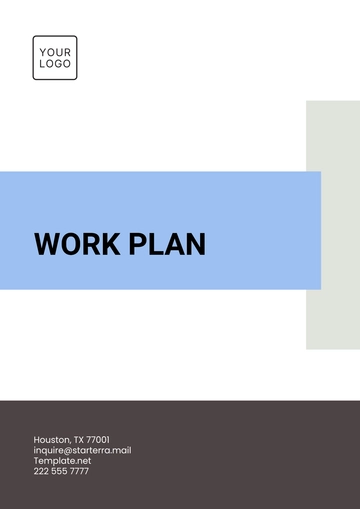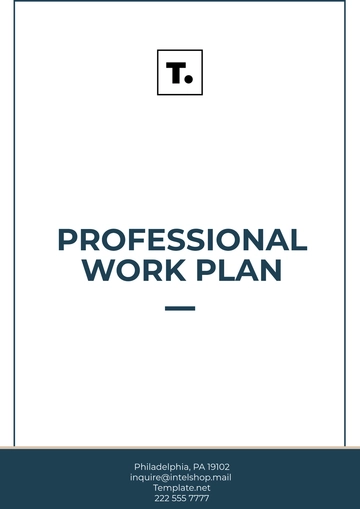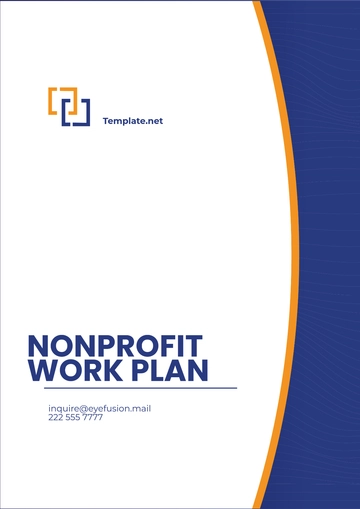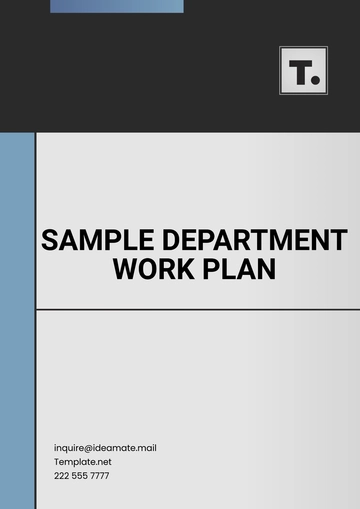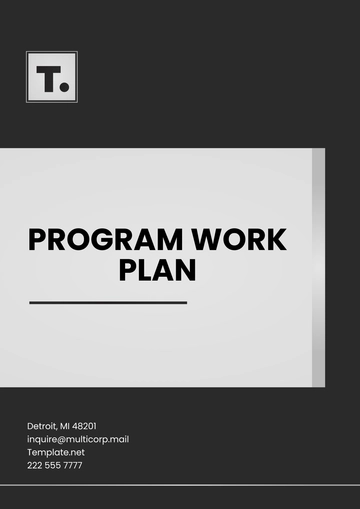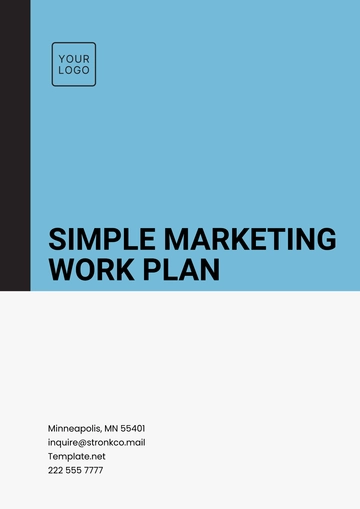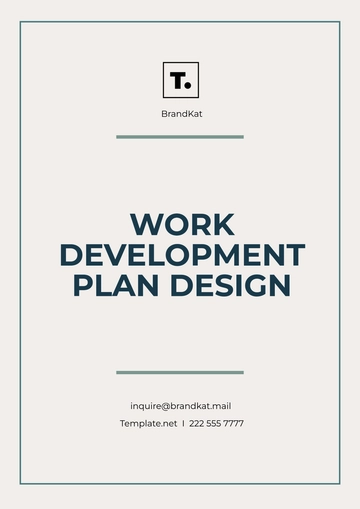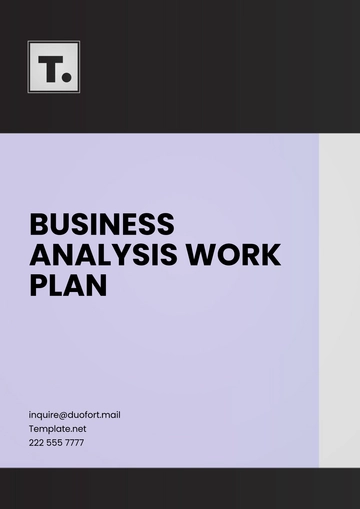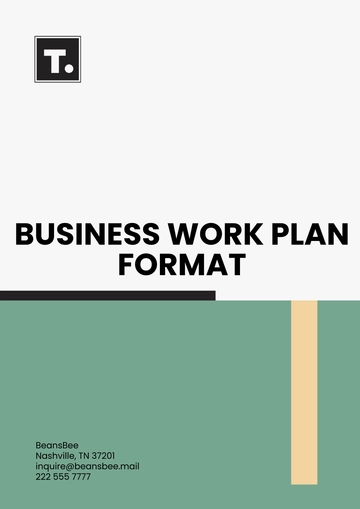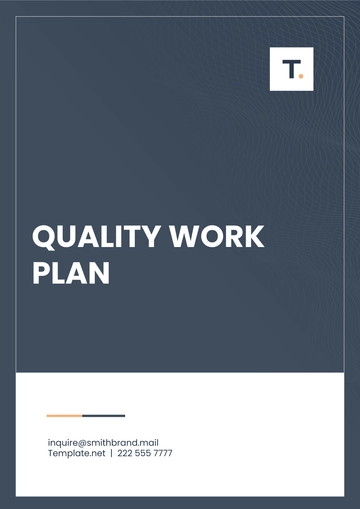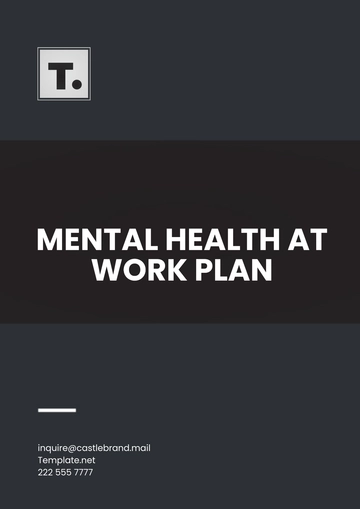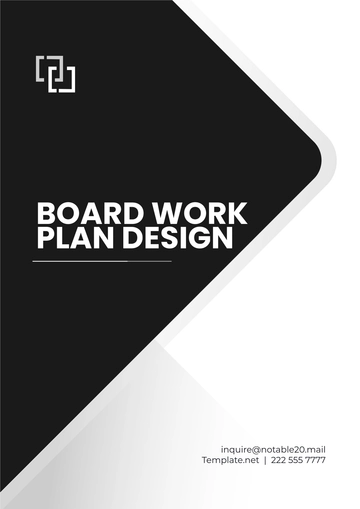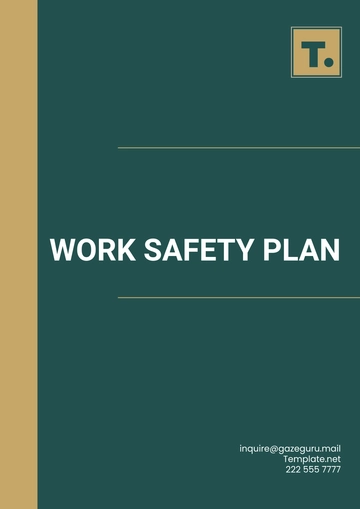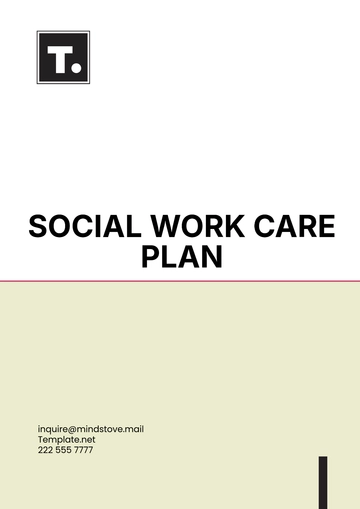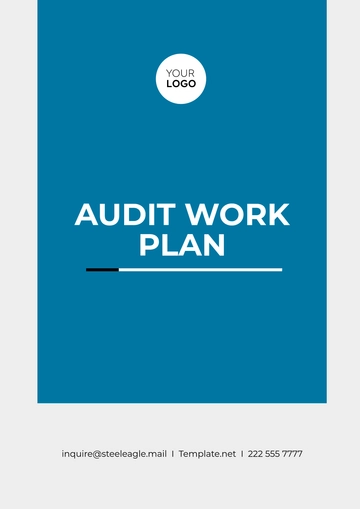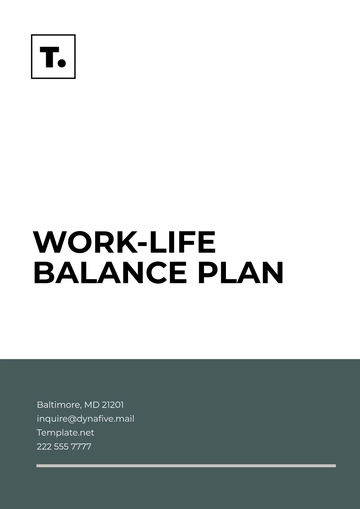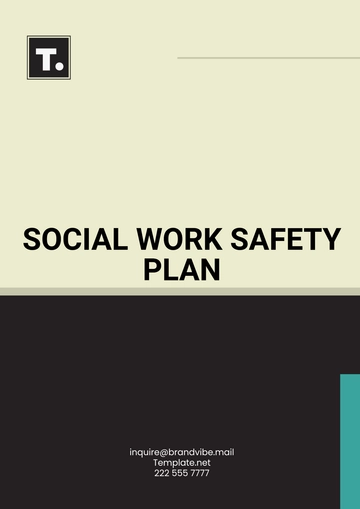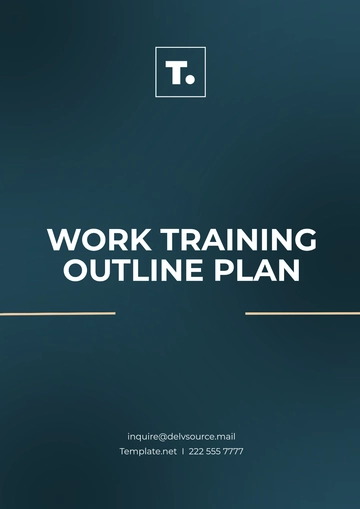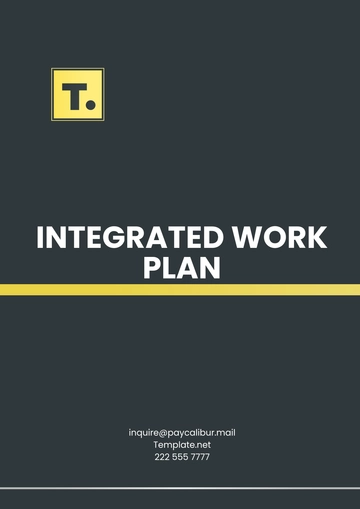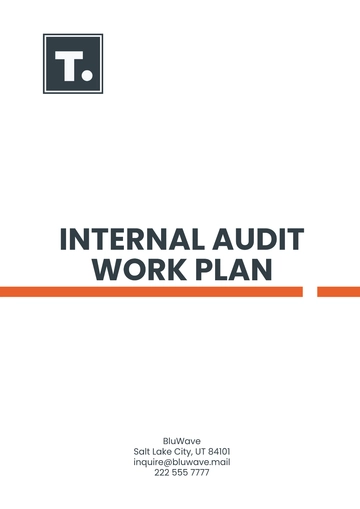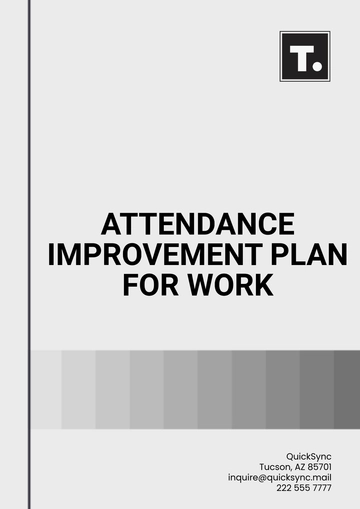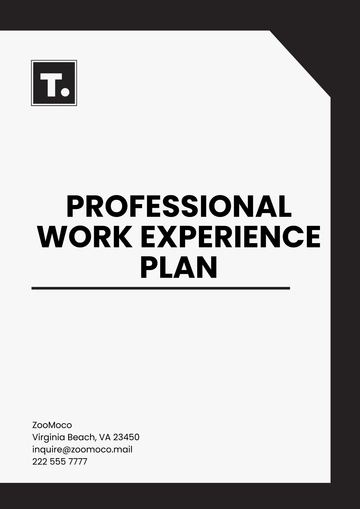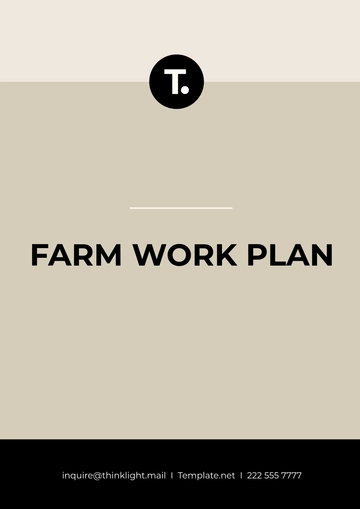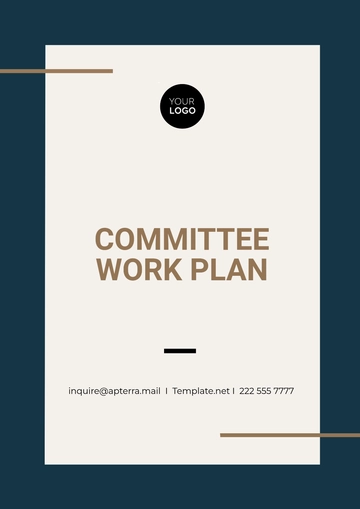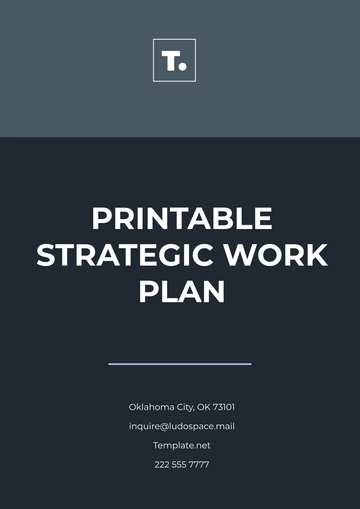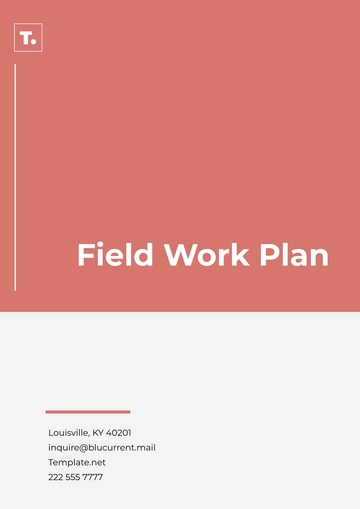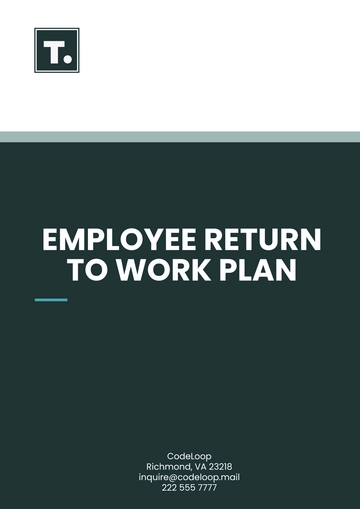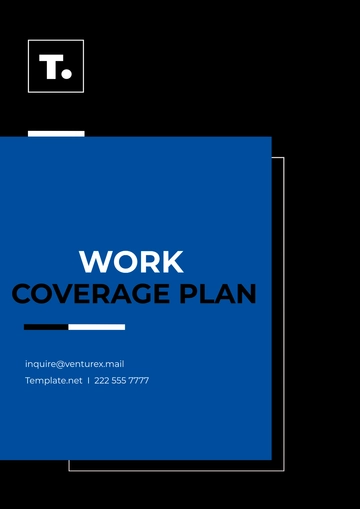Free Employee Work Plan
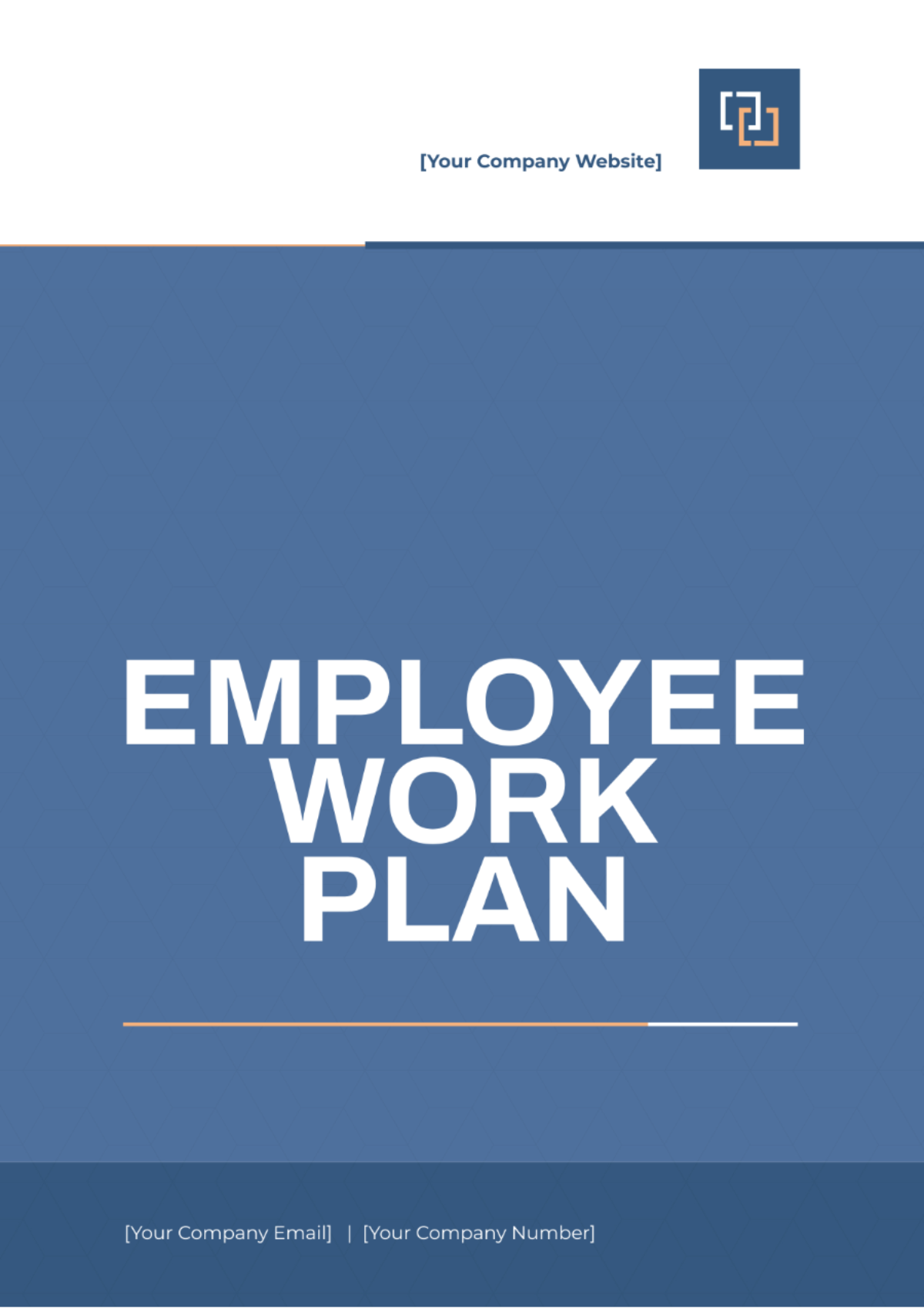
Prepared by: [Your Name]
Company: [Your Company Name]
Address: [Your Company Address]
I. Objective
The primary objective of this plan is to enhance the employee's productivity and effectiveness in their current role. To achieve this, we will set clear, measurable goals tied to specific tasks and establish deadlines for each milestone. This structured approach aims to not only increase efficiency and job performance but also align the employee's growth with the organization’s strategic objectives.
II. Goals and Objectives
Improve Overall Productivity by 20% by the End of the Fiscal Year
Tasks:
Implement a daily tracking system to monitor time spent on various tasks and identify areas for efficiency improvement.
Attend a workshop or training session on time management and productivity enhancement techniques.
Meet bi-weekly with a supervisor to review progress and adjust strategies as necessary.
Timeline:
Set up the tracking system by the end of the first month.
Complete the time management training by the end of the second quarter.
Bi-weekly reviews starting from the first month through the end of the fiscal year.
Increase Client Satisfaction Scores by 15% Through Improved Service Delivery
Tasks:
Conduct client feedback surveys to identify current satisfaction levels and main areas for improvement.
Enroll in customer service training specifically tailored to address identified weaknesses.
Implement new communication protocols to ensure prompt and effective responses to client inquiries and concerns.
Timeline:
Complete initial client feedback survey within the first two months.
Attend customer service training by the end of the first half of the fiscal year.
Establish and apply new communication protocols starting in the third month and ongoing.
Complete All Certification Courses Related to the Current Role by Q3
Tasks:
Identify all required certification courses and enroll in them.
Allocate specific times each week dedicated to study and course completion.
Regularly update the supervisor on progress through course completion reports.
Timeline:
Enroll in all courses by the end of the first month.
Set a study schedule by the start of the second month.
Aim to complete all courses by the end of Q3.
III. Tasks and Responsibilities
Task | Description | Responsible | Deadline |
|---|---|---|---|
Customer Follow-up | Conduct follow-up calls with clients to gather feedback | [EMPLOYEE NAME] | [Date] |
Training on Product X | Participate in training sessions to enhance product knowledge | [EMPLOYEE NAME] | [Date] |
Data Analysis Report | Generate monthly reports on customer engagement metrics | [EMPLOYEE NAME] | [Date] |
IV. Performance Indicators
Quality of work evaluated through random sampling assessments by supervisors.
Adherence to assigned deadlines and milestones.
Increment in client satisfaction as derived from customer surveys and feedback.
V. Timeline
Quarter 1: Review current processes and identify areas for improvement
Objective: To analyze and understand existing operational workflows and identify inefficiencies or areas needing enhancement.
Tasks:
Process Mapping: Document all key processes across various departments. Use tools such as flowcharts or process diagrams.
Employee Feedback: Gather input from staff about challenges and areas for improvement in their day-to-day tasks.
Customer Feedback: Collect and review customer feedback to identify dissatisfaction points and areas where the customer experience can be improved.
Analysis Meeting: Conduct meetings with department heads to review documented processes and feedback, identifying key areas for improvement.
Report Preparation: Summarize findings in a detailed report outlining potential improvements, expected benefits, and any risks or challenges.
Quarter 2: Implement new strategies to enhance customer interaction and satisfaction
Objective: To deploy new strategies that improve the quality of interaction with customers, enhancing overall customer satisfaction and loyalty.
Tasks:
Strategy Development: Based on Q1 insights, develop new customer service strategies or tools, such as CRM systems, customer loyalty programs, or enhanced training for frontline staff.
Pilot Programs: Launch pilot initiatives to test the effectiveness of new customer interaction strategies in controlled environments.
Training: Provide training and resources to employees on new tools and strategies.
Feedback Loops: Establish mechanisms to gather quick and actionable feedback from customers on newly implemented strategies.
Adjustments and Rollout: Analyze the success of pilot programs and make necessary adjustments before a full-scale rollout.
Quarter 3: Enroll and complete career development training specific to employee role
Objective: To enhance employee skills and job satisfaction through targeted training programs, ultimately improving productivity and service quality.
Tasks:
Needs Assessment: Conduct a detailed skills gap analysis for each employee or department to tailor training effectively.
Select Training Programs: Choose appropriate training programs focusing on both soft skills (like customer service, leadership) and hard skills (technical training, software usage).
Enrollment: Facilitate the enrollment of employees in chosen training programs.
Monitoring Progress: Track training progress and completion, offering support where necessary.
Feedback and Evaluation: Gather feedback from employees on the training experience and evaluate the impact of training on their performance.
Quarter 4: Evaluate year-end outcomes and prepare the report for presentation to the management
Objective: To assess the year's overall performance against set goals and prepare for the upcoming year.
Tasks:
Data Collection: Collect comprehensive data on performance metrics impacted by the year’s initiatives (e.g., customer satisfaction rates, employee productivity).
Analysis: Perform a detailed analysis of what strategies worked or didn’t and why.
Report Preparation: Prepare a comprehensive report detailing the outcomes, learning points, and recommendations for the future.
Presentation: Develop a presentation for management, summarizing key findings, supported by data and visuals.
Strategy Session: Hold a meeting with senior management to discuss findings and input for next year’s strategy.
VI. Review and Adjustments
Regular review meetings will be held on a quarterly basis to monitor progress, discuss any challenges, and make necessary adjustments to the plan.
- 100% Customizable, free editor
- Access 1 Million+ Templates, photo’s & graphics
- Download or share as a template
- Click and replace photos, graphics, text, backgrounds
- Resize, crop, AI write & more
- Access advanced editor
Streamline your team's productivity with the Employee Work Plan Template, offered by Template.net. This customizable and downloadable template ensures you can tailor every detail to fit your business needs. Easily editable in our AI Editor Tool, it's designed to keep your workforce organized and focused. Plus, it’s printable for convenient access during meetings or for personal review.
You may also like
- Finance Plan
- Construction Plan
- Sales Plan
- Development Plan
- Career Plan
- Budget Plan
- HR Plan
- Education Plan
- Transition Plan
- Work Plan
- Training Plan
- Communication Plan
- Operation Plan
- Health And Safety Plan
- Strategy Plan
- Professional Development Plan
- Advertising Plan
- Risk Management Plan
- Restaurant Plan
- School Plan
- Nursing Home Patient Care Plan
- Nursing Care Plan
- Plan Event
- Startup Plan
- Social Media Plan
- Staffing Plan
- Annual Plan
- Content Plan
- Payment Plan
- Implementation Plan
- Hotel Plan
- Workout Plan
- Accounting Plan
- Campaign Plan
- Essay Plan
- 30 60 90 Day Plan
- Research Plan
- Recruitment Plan
- 90 Day Plan
- Quarterly Plan
- Emergency Plan
- 5 Year Plan
- Gym Plan
- Personal Plan
- IT and Software Plan
- Treatment Plan
- Real Estate Plan
- Law Firm Plan
- Healthcare Plan
- Improvement Plan
- Media Plan
- 5 Year Business Plan
- Learning Plan
- Marketing Campaign Plan
- Travel Agency Plan
- Cleaning Services Plan
- Interior Design Plan
- Performance Plan
- PR Plan
- Birth Plan
- Life Plan
- SEO Plan
- Disaster Recovery Plan
- Continuity Plan
- Launch Plan
- Legal Plan
- Behavior Plan
- Performance Improvement Plan
- Salon Plan
- Security Plan
- Security Management Plan
- Employee Development Plan
- Quality Plan
- Service Improvement Plan
- Growth Plan
- Incident Response Plan
- Basketball Plan
- Emergency Action Plan
- Product Launch Plan
- Spa Plan
- Employee Training Plan
- Data Analysis Plan
- Employee Action Plan
- Territory Plan
- Audit Plan
- Classroom Plan
- Activity Plan
- Parenting Plan
- Care Plan
- Project Execution Plan
- Exercise Plan
- Internship Plan
- Software Development Plan
- Continuous Improvement Plan
- Leave Plan
- 90 Day Sales Plan
- Advertising Agency Plan
- Employee Transition Plan
- Smart Action Plan
- Workplace Safety Plan
- Behavior Change Plan
- Contingency Plan
- Continuity of Operations Plan
- Health Plan
- Quality Control Plan
- Self Plan
- Sports Development Plan
- Change Management Plan
- Ecommerce Plan
- Personal Financial Plan
- Process Improvement Plan
- 30-60-90 Day Sales Plan
- Crisis Management Plan
- Engagement Plan
- Execution Plan
- Pandemic Plan
- Quality Assurance Plan
- Service Continuity Plan
- Agile Project Plan
- Fundraising Plan
- Job Transition Plan
- Asset Maintenance Plan
- Maintenance Plan
- Software Test Plan
- Staff Training and Development Plan
- 3 Year Plan
- Brand Activation Plan
- Release Plan
- Resource Plan
- Risk Mitigation Plan
- Teacher Plan
- 30 60 90 Day Plan for New Manager
- Food Safety Plan
- Food Truck Plan
- Hiring Plan
- Quality Management Plan
- Wellness Plan
- Behavior Intervention Plan
- Bonus Plan
- Investment Plan
- Maternity Leave Plan
- Pandemic Response Plan
- Succession Planning
- Coaching Plan
- Configuration Management Plan
- Remote Work Plan
- Self Care Plan
- Teaching Plan
- 100-Day Plan
- HACCP Plan
- Student Plan
- Sustainability Plan
- 30 60 90 Day Plan for Interview
- Access Plan
- Site Specific Safety Plan
